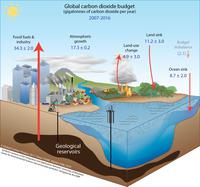 Climate change is driven
primarily by anthropogenic emissions of greenhouse gases, chief among them
carbon dioxide and methane. Two fundamental challenges in carbon cycle science
are (1) to quantify human emissions of greenhouse gases at scales ranging from
the individual to the globe and from hours to decades, and (2) to anticipate
how the “natural” (e.g. oceans, land) components of the carbon cycle will act
to mitigate or to amplify the impact of human emissions. Spatiotemporal
variability in observations of atmospheric concentrations of greenhouse gases
can be used to tackle both challenges, because the atmosphere preserves
signatures of emissions and uptake (a.k.a. fluxes) of greenhouse gases at the
Earth’s surface. The process is analogous to being handed a creamy cup of
coffee and being asked to infer not only when and where the cream was
originally added to the cup, but ideally also who poured it in and why. This
talk will give an overview of the use of inverse problems in carbon cycle
science, focusing on the question of whether we can use atmospheric
observations not only to quantify and locate fluxes but also to directly probe
the underlying biogeochemical processes and their sensitivity to climate
change.
Climate change is driven
primarily by anthropogenic emissions of greenhouse gases, chief among them
carbon dioxide and methane. Two fundamental challenges in carbon cycle science
are (1) to quantify human emissions of greenhouse gases at scales ranging from
the individual to the globe and from hours to decades, and (2) to anticipate
how the “natural” (e.g. oceans, land) components of the carbon cycle will act
to mitigate or to amplify the impact of human emissions. Spatiotemporal
variability in observations of atmospheric concentrations of greenhouse gases
can be used to tackle both challenges, because the atmosphere preserves
signatures of emissions and uptake (a.k.a. fluxes) of greenhouse gases at the
Earth’s surface. The process is analogous to being handed a creamy cup of
coffee and being asked to infer not only when and where the cream was
originally added to the cup, but ideally also who poured it in and why. This
talk will give an overview of the use of inverse problems in carbon cycle
science, focusing on the question of whether we can use atmospheric
observations not only to quantify and locate fluxes but also to directly probe
the underlying biogeochemical processes and their sensitivity to climate
change.

